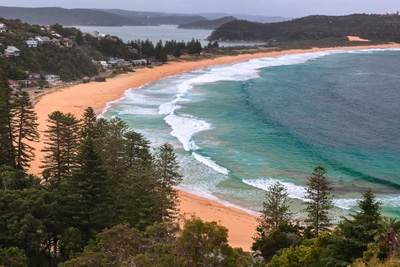
Many different species of whale populate the seas off the coast of Australia. Whether you are visiting Australia or you are taking a holiday in your own country, journeying out to see them is incredibly rewarding. Whales are some of the largest and most majestic creatures on the planet. Due to their stable migration patterns, they can be found reliably and easily by a tour guide. The blue whale is sometimes seen near Sydney, but the humpback whale is definitely the most common species.

Humpback Whales
Humpback whales are a type of baleen whale, which means they do not have teeth, but instead, have baleen in their mouths. Baleen is a set of fibres that resemble a brush. This allows the whales to open their mouths as they’re swimming and strain the seawater through their baleen plates. Fish, plankton, and krill get caught in their baleen plates and the water just passes through.
Obviously, humpbacks are most well known for their body shape that features several humps. They are incredibly large whales; in fact, they are one of the larger species. They are also incredibly acrobatic whales. A humpback whale ranges in size from about 12 to 16 metres (39-52 ft.). They tend to weigh over 30,000 kilograms (70,000 lbs). That makes their acrobatic manoeuvres even more impressive. They breach the water and slap their tails against the water’s surface. Watching humpback whales breaching is one of the biggest appeals of whale watching in Sydney.
Also, many whale watchers like to listen to whale songs. Male humpback whales produce a song that lasts between about 10 and 20 minutes. Marine biologists are not entirely sure of the reason for singing though it is likely used for some kind of mating purpose.
When to Spot Them
Humpback whales travel pretty much all year long, chasing warm water and bountiful prey. They are found all over the world because they travel about 25,000 kilometres (16,000 miles) in a given year. They only eat during the summer and then survive on their stored fat for the entire winter. Also, they live in polar waters during the summer and migrate to tropical waters during the winter to give birth. That means you will likely see them in Australia during the winter.
The skilled tour guides who work for these organisations are well-acquainted with the migratory patterns of humpback whales and can ensure that you see the whales when they are active in your area. There are roughly 80,000 humpback whales in the world and although this might seem like a massive number, it is actually much smaller than it used to be. Considering the amount of water on the planet, 80,000 aren’t actually very many. These whales were hunted by the whaling industry for a very long time and are still the target of whalers. Their population has recovered somewhat, but it is still affected by hunting as well as human tampering.
The conservation efforts of humane industries such as the whale tours help sustain the whale population. They do plenty of good work to protect these wonderful species from harm.














